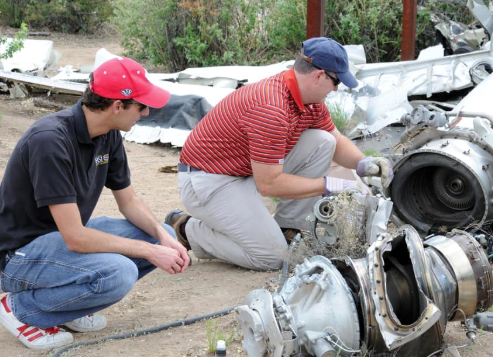10 Health and Safety Myths – #9 Accident Investigation – Tick & Flick?
The unhappy facts are that very few employers understand the value of accident investigation. And even when they grudgingly complete one, it’s generally a “once over lightly”.
That results in poor analysis and superficial corrective actions. Statements like “Inattention”. “Told him/her to be more careful”. “Stupidity”. Such are the realities in many cases. A waste of everyone’s time. And that’s an opinion I share with other safety professionals, based on hundreds of audits.
Why should we do accident investigations?
Let’s say a large light fitting, (one of 50), falls many metres down from a warehouse roof. But it lands harmlessly on the concrete floor in a corner where people rarely go. No one even noticed for a few hours. “Freak accident, no accident investigation”. So the pieces are binned and the glass and dust swept away. And work is not disrupted so life carries on. Four hours later the light fitting is replaced with a new one. Any problems so far?
 With the above example, I think many people have little difficulty understanding the missed opportunity. And the remaining potential for death or serious injury. On the other hand, perhaps some prefer not to think too deeply about it because no one was harmed. But without wishing to labour the point, if it can happen to that light fitting, it can also happen to any, or all of the others – and maybe while someone is underneath. We at least need to examine the wreckage and perhaps check the other fixtures to see whether there was a systemic failure.
With the above example, I think many people have little difficulty understanding the missed opportunity. And the remaining potential for death or serious injury. On the other hand, perhaps some prefer not to think too deeply about it because no one was harmed. But without wishing to labour the point, if it can happen to that light fitting, it can also happen to any, or all of the others – and maybe while someone is underneath. We at least need to examine the wreckage and perhaps check the other fixtures to see whether there was a systemic failure.
By the way, that’s not all. Even if we don’t feel the need to investigate, the authorities might. Because this incident fits the definition of a “Notifiable Incident” under the Health and Safety at Work Act. The scene of the accident should have been preserved and Worksafe notified. And no, it’s not dependent on people actually being harmed.
Gosh! OK then, does the law require Accident Investigation?
Umm…no!
While the current Health & Safety at Work Act does, in fact, use variations of the word “investigate” fifteen times, there is nothing about employers being obliged to do it. Instead, it’s all to do with prosecutions or investigative powers of the authorities. It’s true that the need to “review”, “monitor” and “have information” is scattered here and there under PCBU and Officer’s duties, so you could say these words imply investigations. But pretty lame in my opinion. The previous Health & Safety in Employment Act was very clear about it. Because employers were required to record all accidents (that’s something else we no longer have to do unless they are notifiable). And there was even a form to use that was prescribed by law. We’re all probably still using it.
Furthermore, we were told to investigate those accidents to determine if there was a significant hazard involved. The Act then required us to eliminate, isolate or minimise the significant hazard. Remember that? Simple wasn’t it? I’m not advocating going back there, because that focus was too narrow. I agree we need to control all hazards, because things like near misses represent an opportunity to get ahead of the play. But why abandon the specific requirement to record and investigate non-notifiable accidents? Apparently, to avoid being too prescriptive. And that does not help the theme of this post, which is….
“Even if we were forced to investigate near misses, minor and major accidents at work, very few of us have the skills, time or inclination to do a good job of it”.
Why worry about accident investigation? Let’s get on with the job
 Have you ever watched an episode of “Air Crash Investigation”? Aviation accidents are taken very seriously. Because if aircraft hit the ground (except under control and onto a runway), it mostly turns out very badly. And hundreds of lives can be at stake, all over the world, in similar situations. So investigators are highly trained, work as a team and leave no stone unturned. They not only examine physical evidence, including failure of equipment and structures. They analyse cockpit voice recorders and flight data recorders. Some evidence arises from sophisticated forensics. And they also look at human factors such as pilot fatigue, work history, training and so on. They look at weather records, servicing records and anything else that may have contributed. There are even times they simulate a fault to test if that can be verified as a cause.
Have you ever watched an episode of “Air Crash Investigation”? Aviation accidents are taken very seriously. Because if aircraft hit the ground (except under control and onto a runway), it mostly turns out very badly. And hundreds of lives can be at stake, all over the world, in similar situations. So investigators are highly trained, work as a team and leave no stone unturned. They not only examine physical evidence, including failure of equipment and structures. They analyse cockpit voice recorders and flight data recorders. Some evidence arises from sophisticated forensics. And they also look at human factors such as pilot fatigue, work history, training and so on. They look at weather records, servicing records and anything else that may have contributed. There are even times they simulate a fault to test if that can be verified as a cause.
The report will be peer-reviewed, amended and released for action to all stakeholders. It will typically include multiple corrective actions. Note that. Because most accidents will have perhaps one or two critical causal factors, without which, the accident may not have happened. But there are nearly always contributory factors that had a cumulative effect on the outcome.
Now, I’m not suggesting the above exhaustive and costly process should be applied to everyday employment situations. But, on the other hand, accurate and well thought through corrective actions are sure as heck better than: “Told him/her to be more careful” or “Inattention to the job”. What a waste of time, just to get the dubious result of a “tick & flick”.
How to “unpeel the onion” in an accident investigation

This article is not attempting to detail everything that makes up a start-to-finish investigation. For example, who does it, when it’s to be done, which various techniques exist. There are plenty of guidelines available. Just use “accident investigation guidelines” as a Google search term and you will have all you’ll ever need. But what I would like to illustrate is one very simple technique to get past the superficiality. We’ve all heard of it at some point. It originated in the 1930’s in the context of quality control. The inventor was Sakichi Toyoda, the founder of Toyota, and Toyota still use it today. It is of course, the “5 Whys”. It’s like unpeeling an onion. I know a number of employers do use it for accident investigation, but we need to understand a few subtleties about how to use it before it really works.
First of all, it doesn’t have to be 5 whys. Less might be enough. It could be more. But it’s a process for discovering the root cause of a problem, and the key to using it is that the answer to a question becomes the basis for the next. It’s not useful just to ask a blunt “Why” 5 times. The questioner must listen carefully to each answer and resist the temptation to embark on their own agenda, hypothesis or blame-game.
Let’s use an example
A worker has a pinched finger caused by a rotating roller. You know which roller it was and you can therefore ask: “Why did your finger come into contact with the roller? So if the answer is “The guard was off”, it’s not in the interests of a “5 Whys” process to switch to blame by asking “Why were you working with the guard off?” That question demonstrates the investigator has just introduced a personal agenda, which is intimidating. And off-focus. You are more likely to unpeel the onion by asking: “Why was the guard off? (This has the essential ingredient that it stays on topic by focussing on the previous answer). And it keeps the conversation open. So let’s say the answer was “The guard got broken”.
 We again use the answer to frame the next question. So we don’t ask “Why didn’t you report it? Instead we ask: “Why was the guard broken?” Answer: “The fork lift hit it”. Next question: “Why did the forklift hit it?” Answer: “The driver gets very close to it when they are loading the coils”. Next question: “Why does the driver have to get very close to the guard?” Answer: “Because there’s not enough space to manouevre”. Aha! Now, we really have something that looks like a root cause. Addressing the root cause may make all the other levels of corrective action redundant. But take further corrective actions if any other significant contributory causes were identified during the process.
We again use the answer to frame the next question. So we don’t ask “Why didn’t you report it? Instead we ask: “Why was the guard broken?” Answer: “The fork lift hit it”. Next question: “Why did the forklift hit it?” Answer: “The driver gets very close to it when they are loading the coils”. Next question: “Why does the driver have to get very close to the guard?” Answer: “Because there’s not enough space to manouevre”. Aha! Now, we really have something that looks like a root cause. Addressing the root cause may make all the other levels of corrective action redundant. But take further corrective actions if any other significant contributory causes were identified during the process.
This is a simple but powerful technique and I use it in my “Effective Accident Investigation” training with good results. (See the “We Need Trained People tab in this page). Bear in mind, this method can just as easily be used for near misses.
In summary
The process may get to the root cause before all the 5 whys are used. Just focus on the previous answer and keep going until it would be pointless carrying on. It’s usually quite obvious when that point is reached. And resist the temptation to judge, blame and pursue private agendas and biases. It is very much an exercise in open listening. In the above example, a superficial or ineffective corrective action was beckoning at every step along the way. From the hopelessly inadequate “Be more careful” to disciplinary action for someone who was genuinely trying to get the job done. Even retraining of the forklift driver, who was probably doing a very good job in difficult circumstances and just would not gain anything by being taught to suck eggs. Better to come up with a change to fundamentals than put in place a correction that wasn’t necessary or relevant.
So the message is: To get value out of accident investigation, we need to get past the superficial and start to unpeel that onion. There won’t always be “Eureka” moments but we can ALWAYS do better than “Be more careful next time”. Safety is about doing simple things competently. There really are no mysteries.
Contact me if I can help you with any safety stuff. Call 0800 000 267 for a welcoming chat, or email simon@safetypro.co.nz
- Simon Lawrence is Director of SafetyPro Limited.
- Consulting for safety: Safety Advice, Problem Solving, Audits and Training
- Call 0800 000 267 for a welcoming chat, or email simon@safetypro.co.nz
My 10 Health & Safety Myths. Planned topics and dates.
-
- # 1: Passion for Safety – Please no! 29 August 2019
- #2 Lost Time Injury Rates – Dark Arts in the Boardroom. 18 September 2019
- #3 Zero Harm – Stop Taking it Literally! 9 October 2019
- #4 We Have a Safety Culture – Yeah. Nah! 30 October 2019
- #5 Safety Audits – Smoke and Mirrors 20 November 2019
- #6 Safety Manuals – You’d Think it Would be Simple 31 January 2019
- #7 Safety Policy Statements – You Are Committed to What? 21 February 2020
- #8 The Hazard Register – What Is It Really For? 7 August 2020
- #9 Accident Investigation – Tick & Flick 28 August 2020
- #10 Contractor Management – The Thin Paper Wall 18 September 2020
Check out our SafetyBase software
- View a 4 minute video overview. Please like or share.
- Browse the SafetyBase website.
- Short cut to the all-important Pricing Page. No hidden costs.
- Download a PDF Fact Sheet to show to your Senior Leadership Team.
Call me, Simon, on 0800 000 267 or email simon@safetypro.co.nz You could be trying out this highly effective health and safety software system in minutes

